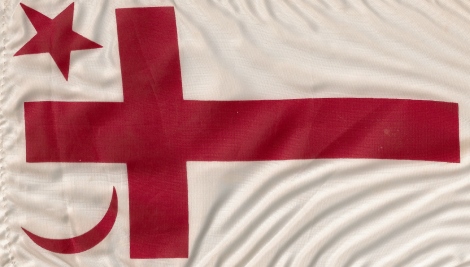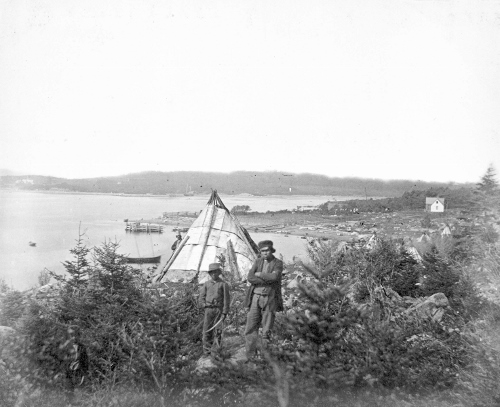First Nations
Although Irish in character, Holy Cross cemetery is first and foremost a Roman Catholic burial ground and individuals from various non-Irish ethnic backgrounds are interred within its gates. Some of those burials were people of First Nations descent. Since the seventeenth-century the First Nations people have had a deep-rooted and complex relationship with Roman Catholicism, and their presence in Holy Cross graveyard is representative of their important role in founding and preserving Catholicism in Nova Scotia.

The roots of Roman Catholicism in Halifax were planted by both the French and Mi’Kmaq peoples in the early eighteenth-century. In 1760, Abbé Pierre Maillard known as the “Apostle to the Mi’Kmaq” arrived in Halifax as vicar-general of Quebec with the responsibility for providing Catholic leadership in colony. Miallard, who spent twenty years labouring among First Nations peoples in Cape Breton, was well known for his close relationship with the Mi’Kmaq and especially his knowledge of their language and culture. Although we can’t be certain what the Mi’Kmag community thought of Miallard’s position in Halifax, we do know that shortly after his arrival many Mi’Kmaq joined in celebrating Halifax’s first Catholic Mass.
Throughout Nova Scotia in the nineteenth-century, the Mi’Kmaq maintained a unique relationship with Catholicism. Often deprived of a regular priest or missionary, the community combined various spiritual customs and Catholic ritual, which resulted in a unique liturgical practice. In places like Chapel Island, Cape Breton, celebrations were held annually in honor of St. Anne, the grandmother of Jesus. Historians have argued that the saint was significant in the First Nations community due to the deep admiration for the wisdom of age.

In the old St. Peter’s Roman Catholic burial ground (located next to St. Mary’s Basilica), there were four Mi’Kmaq burials from 1800-1842
Mary, Buried March 9 1802 (Aged 13)
Adult & Child, Buried April 19 1802
Child, Buried March 27 1821 (three weeks)
Like the Irish, the First Nations peoples buried in Holy Cross after 1843 came from various circumstances. The first burial took place in the spring of 1844 when thirty-year-old Lewis Cope was interred, and the last was in January 1896 when the “stillborn”, Annie Knockwood of Maynard Street was laid to rest.
Lewis Cope, Buried May 5 1844 (Aged 30), Native of Dartmouth
Joseph Cope, Buried October 28 1844 (Aged 21), Native of Dartmouth
Anastatia Paul, Buried November 21 1844 (Aged 88), Native of Halifax
Magdaline Movrice, Buried December 2 1846 (Aged 55), Native of Dartmouth
Ann Glond, Buried January 7 1848 (Aged 21), Native of Dartmouth
Mary Benall, Buried August 20 1852 (Aged 80), Native of Schubenacadie
John Benall, Buried April 11 1853 (Aged 70), Native of Cape Breton
Michael Machay, Buried October 24 1857, Native of the Southeast Plains
Thomas Clode, Buried January 24 1858 (Aged 64), Native of Liverpool
Christina Foe, Buried July 28 1858 (Aged 47), Native of Sydney
Ann Philips, Buried March 2 1859 (Aged 3), Native of Nova Scotia
Nesvel Prasil, Buried March 26 1859 (Aged 45), Native of Cape Breton
Thomas Morris, Buried August 4 1859 (Aged 73), Native of Nova Scotia
Peter Toney, Buried February 12 1860 (Aged 93), Native of Halifax
Female Morris, Buried July 14 1869 (‘Stillborn’)
Prosper Paul, Buried May 1 1871 (Aged 80), Native of Nova Scotia
Francis Hope, Buried March 9 1878 (Aged 20), Native of Halifax
Philip Gooley, Buried April 20 1880 (Aged 65), Native of Halifax
Margaret Toney, Buried January 22 1889 (Aged 96), Native of Nova Scotia
Mary Long, Buried November 27 1891 (Aged 46), Native of Western Canada
Mary Gooley, Buried January 20 1892 (Aged 65), Native of Stewiacke
Annie Paul, Buried November 11 1893 (Aged 40), Native of Halifax
Annie Knockwood, Buried January 18 1896 (‘Stillborn’), Native of Halifax
Further Reading:
Matteo Binasco, “Catholic Missionaries in Acadia.” Journal of the Royal Nova Scotia Historical Society, 10 (2007): 147-162. (View Binasco Article)
Rosalie Marie Francis, “The Mi’kmaq Nation and the Embodiment of Political Ideologies: Ni’kmaq, Protocol and Treaty Negotiations of the Eighteenth Century,” (M.A. Thesis, Saint Mary’s University, 2003). (View Francis Thesis)
Julian Gwyn, “The Mi’kmaq, Poor Settlers, and the Nova Scotia Fur Trade, 1783-1853.” Journal of the Canadian Historical Association, 14, No. 1 (2003): 65-91. (View Gwyn Article)
J. Sharon Ingalls, “Attitudes towards the Micmac in Nova Scotia, 1788-1900” (M.A. Thesis, Saint Mary’s University, 1992). (View Ingalls Thesis)
John Lenhart, History Relating to Manual of Prayers, Insturctions, Psalms and Hymns in Micmac Ideograms used by Micmac Indians of Eastern Canada and Newfoundland (Pittsburgh: John Lenhart, n.d.).
Andrew Parnaby, “The Cultural Economy of Survival: The Mi'kmaq of Cape Breton in the Mid-19th Century” Labour / Le Travail, 61 (Spring, 2008): 69-98. (View Parnaby Article)
Jennifer Reid, Finding Kluskap: A Journey into Mi'kmaw Myth (Penn State University Press, 2013).
Jennifer Reid, Myth, Symbol, and Colonial Encounter: British and Mi’kmaq in Acadia, 1700-1867 (Ottawa: University of Ottawa Press, 1995).
Peter L. Twohig, “Health and the Health Care Delivery System: The Micmac in Nova Scotia” (M.A. Thesis, Saint Mary’s University, 1991). (View Twohig Thesis)
